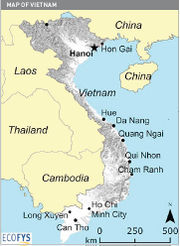Click here to register!
Vietnam Energy Situation
| Socialist Republic of Vietnam | |||
|---|---|---|---|
| Capital | Hanoi 21°2′N 105°51′E | ||
| Official Languages(s) |
Vietnamese | ||
| Government | Marxist–Leninist single-party state | ||
| President | Trương Tấn Sang | ||
| Prime Minister | Nguyễn Tấn Dũng | ||
| 'Total Area '( km²) | 331,210 | ||
| Population | 90,388,000 (2012 estimate) | ||
| Rural Population | (year) | ||
| GDP (Nominal) | $138.071 billion (2012 estimate) | ||
| GDP Per Capita | $1,527 | ||
| Currency | đồng (VND) | ||
| Time Zone | (UTC+07) | ||
| Electricity Generation | TWh/year (year) | ||
| Calling Code | +84 | ||
| Access to Electricity | |||
| Wind energy (installed capacity) | MW (year) | ||
| Solar Energy (installed capacity) | MW (year) | ||
Overview
Vietnam remains one of world’s fastest growing economies, having sustained an average growth rate of 6.8% over the last seven
years, and currently has a per capita GDP of about £1,100. In spite of these impressive gains, the vast majority of the population continues to live in rural areas where incomes are far below the national average, and is largely dependent on small-scale farming or animal husbandry. In addition, Vietnam is highly vulnerable to adverse impacts of climate change, which may eliminate the much of the gains made in poverty reduction and economic development.
In the last decade, fast industrialization and the economy’s expansion lead to its rapidly growing energy consumption. An increased dependency on fossil fuels is foreseen, and Vietnam is already a net energy importer. Vietnam targets to increase the share of renewable energy in total, commercial, primary energy from 3% in 2010 to 5% in 2020 and 11% by 2050.
Energy Situation
Rural Energy Supply
Wood is still the main source of energy for over 56% of the country, mainly rural people, over 80% of the country uses wood on a daily basis for cooking purposes. Wood collection time has increased, and wood purchase prices also continue to increase. The BUS2011-2012 survey showed that the households were spending on average around 390.000 VND (€ 14) on fuel costs, of which around 75.000 VND (€ 2,5) was for firewood, 95.000 VND (€ 3) for coal and around 100.000 (€ 3,5) for LPG.
Biogas
Historically, three factors have favoured investment in biogas plants in Vietnam. Firstly, the country has a hot and humid climate, which is a precondition for the efficient functioning of a bio-digester. Secondly, it has a large animal husbandry sector, which provides ample feedstock for bio-digesters, Vietnam had the world fourth-largest population of pigs, after China, the USA and Brazil) (2010). Thirdly, most of Vietnam’s animal husbandry sector is managed by small family farms, and small biogas plants are financially more attractive and are readily affordable. Most biogas plants have a capacity below 50m3, and are almost exclusively in use by rural households and small farms involved in raising pigs.
In recent years, several developments have taken place that favour further growth of the biogas sector.
- Rapid growth of the animal husbandry sector: From 2000 to 2010, the population of pigs in Vietnam increased by about 35%, from about 20 million to over 27 million, and Ministry of the Agriculture and Rural Development (MARD) expects this number to increase to almost 35 million by the end of 2020. Cattle breeding increased at even higher rates, and the cattle population is expected to double from 5.8 million in 2010 to 12.5 million in 2020. Because of animal diseases, both the pig and cattle population declined from 2009 to 2011, but recent data indicate that growth has resumed.
- Increasing environmental awareness: Both the Government of Vietnam (GoV) and the public have become increasingly concerned about environmental pollution. “Biogas User Surveys” undertaken by National Biogas Program (BPD) during 2007-2012 indicate that reducing environmental pollution is a primary consideration of the farmer for the purchase of a bio-digester. Because Vietnam is highly vulnerable to the adverse impacts of climate change, there is also an increasing awareness of the need to reduce greenhouse gas (GHG) emissions, and domestic bio-digesters will make a significant contribution to those reductions.
- High and rising energy prices: Biogas is used for cooking, lighting and other activities (some of which are income generating like tofu making and/or rice wine production), thereby reducing traditional fuel use and costs. In recent years, fuel prices have increased at much higher rates than the construction cost of biogas plants.
Policy Framework, Laws and Regulations
Energy Policy
Since 2011, the Government put the Energy Efficiency Laws in force. According to the National energy strategy document (Master Plan VII), the share of RE in electricity generation was set to increase from 3.5% in 2012 to 4.5% in 2020 and 6% in 2030. In order to adapt the shortage of fuels, bio fuels are an option of the energy development strategy. The goal is to reach 5 million tons of E5, B5 whcih is equivalant to 1.0% national demand for gasoline and diesel by 2015; by 2025 the Government wants to reach 1.8 million tons of ethanol and vegetable oil, or 5% of oil and gasoline demand by 2025.
Institutional Set-up and Actors in the Energy Sector
Public Institutions
Other major activities in the country financed by BMZ or DGIS
Non Governmental Service Providers for Rural Areas in the Field of Energy
Projects implementing NGOs:
Commercial service provider:
Micro-Finance Institutions:
References




















